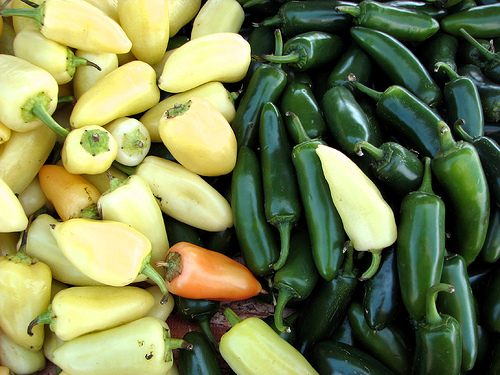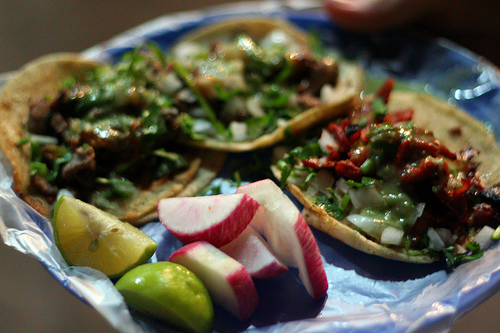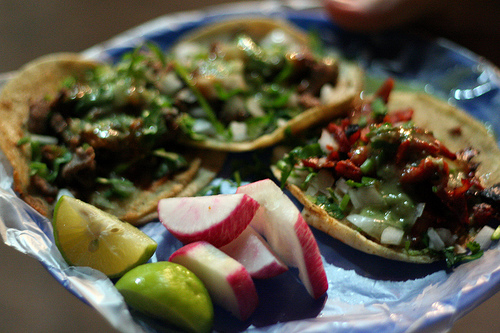Many people claim they don’t have time to cook fresh meals “from scratch.” In Tom’s Kitchen, Grist’s food editor discusses some of the quick and easy things he gets up to in … well, his kitchen.
 It don’t mean a thing if it ain’t got that zing.Photo: sgraceNormally I cook and eat relatively low on the food chain: veggies, grains, legumes, goosed up by eggs and a little cheese. But once or twice a week, I revert to what the U.K. environmentalist/farmer Simon Fairlie has declared a “benign extravagance“: pasture-raised meat. Even so, I prefer to skew Tom’s Kitchen to the food chain’s lower realms. Given that Americans eat on average more than half a pound per day per capita, most folks should probably be eating less — and food writers like me should be giving them tips for doing so.
It don’t mean a thing if it ain’t got that zing.Photo: sgraceNormally I cook and eat relatively low on the food chain: veggies, grains, legumes, goosed up by eggs and a little cheese. But once or twice a week, I revert to what the U.K. environmentalist/farmer Simon Fairlie has declared a “benign extravagance“: pasture-raised meat. Even so, I prefer to skew Tom’s Kitchen to the food chain’s lower realms. Given that Americans eat on average more than half a pound per day per capita, most folks should probably be eating less — and food writers like me should be giving them tips for doing so.
Well, forgive me, vegans, for I have sinned. My editor has demanded a Tom’s Kitchen column for the holiday weekend, and all I’ve got ready to go is what I made a few nights ago: tacos of braised grass-fed beef short ribs in pasilla-chile sauce.
And … it’s really, really good. And easy. So consider it for a long-weekend meal. But damn it, eat less meat overall.
Really, this preparation could be lots worse on the carnivory front. One way to eat less meat, even while cooking it for dinner, is to serve it a bit sparingly, alongside a bunch of other filling stuff. That’s what I did with these tacos. I made kidney beans flavored with chipotle chile and cumin, a big pan of sautéed kale, a red-cabbage salad with lime vinaigrette, and I heated up some store-bought corn tortillas. With all of that going on, no one seemed to mind that I had braised off just four not-very-large short ribs for all four of us to share. Also, I knew one of my friends is eschewing meat these days, and I wanted to make sure she’d get a satisfying meal if she abstained from the meat entirely. (She didn’t.)
A note on short ribs: Such tough, bone-in cuts offer many advantages. They’re way cheaper than center cuts (i.e., steaks and loins); cooked slowly, they become amazingly tender; and as they braise, the bones essentially turn the cooking liquid into a rich stock, deeply flavorful and full-bodied.
This recipe is a tribute to the cooking in the glorious food markets of Mexico City, from which I just returned, smuggling in my suitcase bags of contraband dried chile peppers. Like most of my slapped-together forays into other nations’ flavor palates, there’s nothing particularly authentic about this; but it does capture some of the dramatic flavor of Mexican cooking.
 Taco time.Photo: Taylor McKnightGrassfed Short-Rib Tacos in Pasilla-chile Sauce
Taco time.Photo: Taylor McKnightGrassfed Short-Rib Tacos in Pasilla-chile Sauce
Serves 4
Note: This is a dish best started a day ahead of serving or in the morning for a weekend-night dinner. Dried chiles like pasillas and chipotles can be found in many supermarkets and all Mexico-style “tiendas.”
Mise en place
4 grass-fed short ribs (approximately 2 pounds)
Vegetable oil for sauteeing
Sea salt and freshly ground back pepper
For braising liquid
1 onion, unpeeled, sliced
3 cloves garlic, unpeeled, crushed with the flat side of a knife
1 bay leaf
1 dried chipotle pepper
For sauce
3 pasilla chiles
2 corn tortillas
1 small can of canned organic tomatoes
2 cloves garlic
To serve:
8-12 corn tortillas, heated, for tacos
1 bunch cilantro or parsley, chopped
Radishes, sliced thin
Lots of side dishes (see above for ideas)
In a sturdy frying pan just large enough to hold all the ribs at once, add just enough oil to cover the bottom of the pan and turn heat to medium. Using paper towels, or preferably a kitchen towel that will be quickly dropped into the hamper, tamp dry the ribs on all sides. (This is key; wet ribs won’t brown.)
Season the ribs on all sides with salt and pepper and add to hot pan, bone side up. Brown the ribs on as many sides as you can. If the pan begins to scorch, turn the heat down. When the ribs are well browned, remove them and set them aside, and turn heat to low. Add a cup or so of water to deglaze the pan, which means scraping the pan with a wooden spoon to liberate the flavorful browned bits that accumulated there. Turn off heat.
Now arrange the ribs bone-side-down in a Dutch oven-style pot (heavy) with a tight-fitting lid — or, better yet, a crock pot. Arrange the sliced onion, the garlic, the bay leaf, and the chipotle chile over them. Add the water from the frying pan, and add enough extra water to submerge the ribs halfway. If using a Dutch oven, bring slowly to a simmer, cover, and turn heat to lowest setting. (You can also place the covered pot in an oven pre-heated to 300 degrees.) If using a crock pot, cover and turn to high setting; when the liquid begins to simmer, turn to low setting.
Let the ribs simmer for about 3 hours, then check. The meat should be fork tender and falling off the bone. (If it’s not, allow more time.)
When the meat is done, turn the heat off and remove the ribs and any meat that has fallen off, setting them aside. (If making the dish a day ahead, wrap in foil and store in fridge overnight. If you’re making it for same-day eating, you can leave them out on a plate, covered with foil.) Pour the hot liquid through a fine strainer, straining out onions, etc., into a large measuring cup or wide-mouth mason jar. Allow to cool in the fridge for at least an hour. This will allow the fat to rise to the top and harden, so it can easily get taken out. Defatting the stock in this way will lead to a clearer-tasting, more vivid sauce.
Now make the sauce. Toast the pasillas over medium heat in a dry, un-oiled skillet — about 20 seconds on each side. Place them in a bowl and cover them with hot water to rehydrate for at least 4 minutes. In the same skillet, toast the tortillas until they harden and brown a little (without burning); and toast the garlic cloves for a few minutes on each side. One they’re nicely toasted, remove and peel them.
In a blender or food processor, add the can of tomatoes, a tortilla torn into several pieces, one of the rehydated chilies, the garlic, a good pinch of stock, and the defatted cooking liquid. Purée.
Now assess the sauce for texture and level of heat. If it seems a little thin, add another scrap of tortilla. If it isn’t quite fiery enough, tear of another modest piece of of rehydrated chile. Purée and assess again. When you have a nice, sauce-like texture and the desired level of heat, pour the sauce into a medium-sized pot and turn heat to low.
Add the cooked ribs, cover, and let them come slowly to a simmer. When they’re heated through, spread all the meat and bone on a platter, and spoon a little sauce over it, reserving the rest to serve at table in a bowl. Garnish with chopped cilantro, sliced radishes, a lashing of your best sea salt, and a grind or five of black pepper. Serve with hot
tortillas and side dishes.



